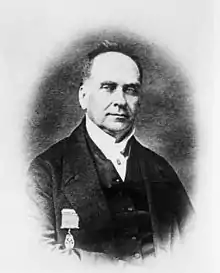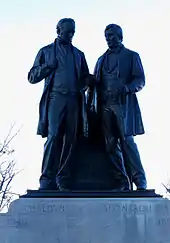| Defunct pre-Confederation electoral district | |
|---|---|
| Legislature | Legislative Assembly of the Province of Canada |
| District created | 1841 |
| District abolished | 1867 |
| First contested | 1841 |
| Last contested | 1863 |
Rimouski was an electoral district of the Legislative Assembly of the Parliament of the Province of Canada, in Canada East, in the Lower-Saint Lawrence region. It was created in 1841 and was based on the previous electoral district of the same name for the Legislative Assembly of Lower Canada. It was represented by one member in the Legislative Assembly.
The electoral district was abolished in 1867, upon the creation of Canada and the province of Quebec.
Boundaries
The Union Act, 1840 merged the two provinces of Lower Canada and Upper Canada into the Province of Canada, with a single Parliament. The separate parliaments of Lower Canada and Upper Canada were abolished.[1]
The Union Act provided that the pre-existing electoral boundaries of Lower Canada and Upper Canada would continue to be used in the new Parliament, unless altered by the Union Act itself.[2] The Rimouski electoral district of Lower Canada was not altered by the Act, and therefore continued with the same boundaries which had been set by a statute of Lower Canada in 1829:
The electoral district of Rimouski was thus on the south shore of the Saint Lawrence at the beginning of the Gaspé peninsula (now in the Bas-Saint-Laurent administrative region).
Members of the Legislative Assembly
Rimouski was a single-member constituency in the Legislative Assembly.[2]
The following were the members of the Legislative Assembly for Rimouski. "Party" was a fluid concept, especially during the early years of the Province of Canada. Party affiliations are based on the biographies of individual members given by the National Assembly of Quebec, as well as votes in the Legislative Assembly.[4][5][6]
| Parliament | Members | Years in Office | Party | |
|---|---|---|---|---|
| 1st Parliament 1841–1844 |
Michel Borne[lower-alpha 1] | 1841–1842 | French-Canadian Group | |
| Robert Baldwin[lower-alpha 2] |  |
1843–1844 (by-election) |
Reformer | |
Notes
- ↑ Resigned seat on December 15, 1842 to allow Robert Baldwin to stand for election: Côté, Appointments and Elections, p. 59, note (36).
- ↑ Elected in by-election, January 30, 1843: Côté, Appointments and Elections, p. 59, note (37).
Significant elections

In 1842, Louis-Hippolyte Lafontaine and Robert Baldwin formed the first joint ministry in the Province of Canada, and were appointed to the Executive Council by the Governor General. At that time, the law required that if members of the Legislative Assembly took a position under the Crown, the members' seats were vacated and they had to stand for re-election. Lafontaine was easily re-elected in his riding, but Baldwin was defeated in his riding of Hastings in Canada West.[7]
To ensure his colleague could re-enter the Legislative Assembly, Lafontaine arranged for Michel Borne, the member for Rimouski, to resign his seat so Baldwin could stand for election there. (Borne was in his sixties and had infrequent attendance at Parliament.) Baldwin, an anglophone from Canada West, was elected by the heavily francophone, but pro-reform, voters of Rimouski.[7][8][9]
The by-election was important for the success of the Lafontaine-Baldwin alliance, and also as an early step in building political parties within the Province of Canada based on common political views, rather than purely ethnic affiliations.[10]
Abolition
The district was abolished on July 1, 1867, when the British North America Act, 1867 came into force, creating Canada and splitting the Province of Canada into Quebec and Ontario.[11] It was succeeded by electoral districts of the same name in the House of Commons of Canada[12] and the Legislative Assembly of Quebec.[13]
References
- ↑ Union Act, 1840, 3 & 4 Vict., c. 35, s. 2.
- 1 2 Union Act, 1840, s. 18.
- ↑ An Act to make a new and more convenient subdivision of the Province into Counties, for the purpose of effecting a more equal Representation thereof in the Assembly than heretofore, SLC 1829, c. 73, s. 1, para. 3.
- ↑ J.O. Côté, Political Appointments and Elections in the Province of Canada, 1841 to 1860 (Quebec: St. Michel and Darveau, 1860), pp. 43–58.
- ↑ Québec Dictionary of Parliamentary Biography, from 1764 to the present.
- ↑ Paul G. Cornell, Alignment of Political Groups in Canada, 1841–67 (Toronto: University of Toronto Press, 1962; reprinted in paperback 2015), pp. 93–111.
- 1 2 J.M.S. Careless, The Union of the Canadas — The Growth of Canadian Institutions, 1841–1857 (Toronto: McClelland and Stewart, 1967), p. 75.
- ↑ "Biography of Michel Borne". Dictionnaire des parlementaires du Québec de 1792 à nos jours (in French). National Assembly of Quebec.
- ↑ Paul G. Cornell, Alignment of Political Groups in Canada, 1841–67 (Toronto: University of Toronto Press, 1962; reprinted in paperback 2015), pp. 93, 94.
- ↑ James H. Marsh, "Editorial: Baldwin, LaFontaine, and Responsible Government", Canadian Encyclopedia, October 15, 2019.
- ↑ British North America Act, 1867 (now the Constitution Act, 1867), s. 6.
- ↑ Constitution Act, 1867, s. 40, para. 2
- ↑ Constitution Act, 1867, s. 80.
![]() This article incorporates text from this source, which is in the public domain: Statutes of Lower Canada, 13th Provincial Parliament, 2nd Session (1829), c. 74
This article incorporates text from this source, which is in the public domain: Statutes of Lower Canada, 13th Provincial Parliament, 2nd Session (1829), c. 74